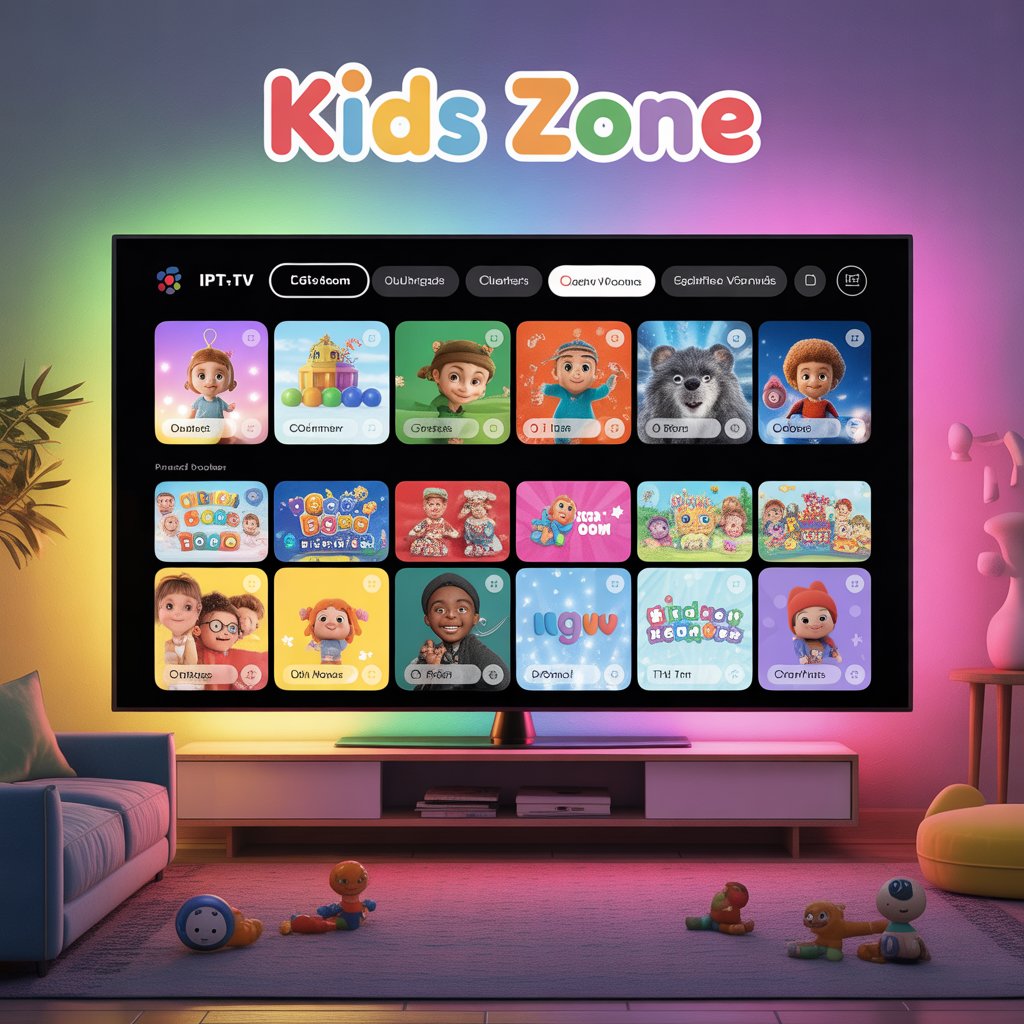IPTV for kids on Smart TV

Quick Definition (Snippet-Friendly)
IPTV for kids describes internet-delivered TV and streaming services curated or configured for children—featuring age-appropriate content, parental controls, educational channels, and tools to keep viewing safe and meaningful.
Introduction
Families are turning to IPTV for kids to get on-demand shows, educational programs, and tighter parental controls than traditional TV. IPTV for kids can be an excellent way to combine entertainment and learning when you choose licensed services, configure reliable safeguards, and create a healthy viewing routine.
Short tip: always create separate child profiles and protect settings with a PIN—this simple step immediately improves safety for IPTV for kids.
Why Parents Choose IPTV for Kids
Compared with legacy cable, IPTV for kids often offers more flexibility, on-demand episodes, and app-based parental controls. Parents like:
- Curated, age-appropriate channel lineups
- On-demand educational content and playlists
- Finer control over what and when children watch
- Compatibility with tablets and smart TVs kids already use
That said, parents must verify legality and licensing—only licensed IPTV services should be used for children’s programming.
Key Features to Look For in Kid-Friendly IPTV
When comparing providers and apps for IPTV for kids, prioritize these features:
- Parental profiles & PIN-protected settings — separate accounts for kids with locked controls.
- Age filters — content categorized by age ranges, such as 2–5, 6–9, 10–12.
- Time limits & schedules — daily screen time caps and bedtime locks.
- Educational channels & playlists — science, language, early literacy, and nature shows.
- Simple UI — large icons and minimal search for younger users.
- Reliable playback — adaptive streaming to reduce buffering during viewing.
Step-by-Step Setup for IPTV for Kids
Follow these practical steps to get started quickly and safely.
1. Choose a Licensed, Reputable Service
Start by selecting a provider that offers clear licensing and strong reviews. Licensed options reduce the legal and content-quality risks associated with unverified streams.
2. Install on Compatible Devices
Install the selected IPTV app on smart TVs, Fire/Android/Apple TV boxes, and tablets. Confirm the app supports child profiles.
3. Create Child Profiles & Lock Settings
Make a profile for each child, set an appropriate content level, and lock admin settings with a PIN to prevent accidental changes.
4. Configure Time Limits & Bedtime Locks
Set daily viewing limits, and schedule automatic “lights out” times to help preserve sleep hygiene.
5. Curate Starter Playlists
Preload educational series, short-form learning clips, and favorite cartoons so kids have a safe set of choices without searching.
6. Monitor & Talk
Check watch history regularly and discuss what your child watched—this reinforces learning and keeps you informed about preferences or issues.
Kid-Friendly Apps & Platforms That Work Well with IPTV
Many mainstream streaming apps and dedicated children’s platforms can integrate into an overall IPTV-for-kids strategy. Common examples (availability varies by region):
- YouTube Kids — kid-focused video discovery (review autoplay settings for IPTV for kids).
- PBS Kids — trusted educational shows and activities.
- Network apps (Nick Jr., Sesame Street, Noggin) — official apps with licensed content.
- Kid-specific streaming services (Kidoodle.TV, etc.) — built around child safety.
Tip: Combine a central IPTV app launcher with separate children’s apps to keep navigation simple for kids.
Content Ideas & Smart Usage Tips for Parents
Use IPTV for kids to boost learning and structure screen time—try these easy routines.
Theme-Based Learning
Pick a theme (like “dinosaurs” or “space”) each week and build a playlist of short shows, documentaries, and hands-on activities to follow up after watching.
Short Sessions & Active Breaks
Prefer 15–25 minute episodes or clips interleaved with offline play to keep attention healthy and avoid long passive viewing sessions.
Family Co-Viewing
Co-watch once or twice a week and ask open-ended questions about the story to boost comprehension and critical thinking.
Language Practice
Schedule part of the week where shows play in a second language to build passive vocabulary—an easy, low-pressure language exposure technique.
Safety, Privacy & Legal Considerations
Parents must treat IPTV for kids like any other online service—pay attention to privacy, rights to content, and technical safety.
Use Licensed Content Only
Avoid free “grey-market” IPTV lists that distribute copyrighted content without permission. Stick with licensed providers to ensure quality and legality for IPTV for kids.
Protect Data & Privacy
Create accounts with minimal personal information, disable unnecessary location or voice personalization for a child profile, and avoid storing payment details in child-accessible areas.
Network & Device Security
Use strong router passwords, keep device firmware updated, and lock device settings—these steps reduce the chance of accidental sideloading or unsafe app installs.
Common Issues & Troubleshooting for IPTV for Kids
- Buffering/lag: check your internet speed and enable adaptive streaming or switch to wired connection where possible.
- Inappropriate content appeared: immediately lock the profile, remove the content, and adjust age filters.
- Autoplay leads to long sessions: disable autoplay in the app or set a playlist that finishes after one or two items.
- Account hijack risk: use unique passwords and enable two-factor authentication for adult admin accounts.
Frequently Asked Questions (FAQ)
Is IPTV for kids safe?
IPTV for kids can be safe when you choose licensed providers, enable parental controls, and supervise usage. Always test profiles before giving kids full access.
Can IPTV replace real-world play and reading?
No—screen time should complement, not replace, active play, reading, and family interactions. Use IPTV for kids as a learning tool within a balanced daily routine.
What devices work best?
Smart TVs, tablets, streaming boxes (Fire TV, Apple TV, Android TV) and some dedicated IPTV boxes work well. Pick devices with reliable parental-control options.
Sample 30-Day Plan to Introduce IPTV for Kids
Here’s a practical rollout to adopt IPTV for kids without rushing:
| Week | Focus | Actions |
|---|---|---|
| Week 1 | Research & Select | Compare licensed services; shortlist ones with parental controls |
| Week 2 | Install & Configure | Install apps, create child profiles, lock settings |
| Week 3 | Start & Monitor | Use curated playlists, check history, adjust filters |
| Week 4 | Refine | Expand approved content, set long-term schedules, solicit child feedback |
SEO & Content Tips for Your Blog About IPTV for Kids
If you run a parenting or tech blog, keep these content tips in mind:
- Use clear headings with variations: “IPTV for kids”, “kid-friendly IPTV”, “IPTV parental controls”.
- Include internal links: e.g. [Link to related article on meditation techniques] and [Link to related article on streaming safety].
- Add external, credible sources: e.g. [Link to WHO report on mental health] or [Link to FCC guidelines on children’s media].
- Use descriptive alt text for images: “IPTV for kids child watching educational show”.
Final Thoughts
Used thoughtfully, IPTV for kids can be a powerful tool to blend entertainment and education. The keys are choosing licensed services, configuring strong parental controls, and keeping an ongoing conversation with your child about healthy screen habits.
If you want, I can help you compare services available in your region, build a custom starter playlist for your child’s age, or draft a family screen-time policy.
Ready to Get Started?
Want personalized help—like step-by-step setup on your specific device, a curated playlist for ages 3–6, or a printable family screen-time chart? I can help with any of those.
Subscribe for more parenting-tech guides or contact me to get a tailored IPTV-for-kids setup